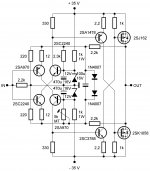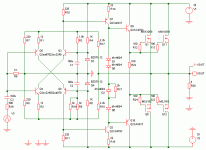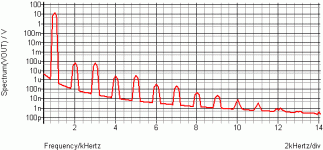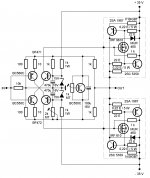Last edited:
It looks in this concept with 8 transistors, lateral MOSFET output's would give the best THD figures, loading the VAS less than other versions.
MOSFET driver is another option, maybe ... 🙄
Laterals would perfectly suit if...they are driven by an EF stage,
as the high frequency THD would rise a lot if there s no bufferisation
of the VAS, even if it has a relatively high standing current.
Also, two pairs would be necessary to have good THD distribution.🙂
That makes a lot in respect of the projected simplicity , but high
perfs are not achievable with low component count , unless
one use a dedicated high perf IC driver.🙁
I also thought like Wahab that the Szikley is around the output Fets, so one driver stage more. Yes, this gets us more away from the simplicity of the first version.
You're thinking about something like that. 🙄
Somewhat like this..🙂
Attachments
Yes, that looks good to me.
OK, that's good.
I know we could easily go to 20 transistors version in a split second, but that maybe will happen in another thread, another time. 🙂
So, we have to stay at most 8 transistors only concept, this ensures discrete symmetrical circuit simplicity, on the other hand on us is to find the best sch configuration within these limits for the best performance. It sounds like a challange to me. 😀
Last edited:
Somewhat like this..🙂
Nooooo, too many transistors according to thread theme. 😱
Besides this is not somewhat Joachim meant. Check my last sch, DRAIN output ...
So, to stay at most 8 transistors only concept, this ensures discrete circuit simplicity, on the other hand on us is to find the best sch configuration within these limits for the best performance. It sounds like challange. 😀
Either linearity or OLG or both have to be improved for better perfs,
but in all cases , this is possible only with additionnal components...😱
I would then turn around the Fets ( post 205 ) but that may create oscillation problems.
It is quite possible , stability is not unconditional..
Either linearity or OLG or both have to be improved for better perfs,
but in all cases , this is possible only with additionnal components...😱
Agree but to find the best sounding and good (not perfect) measuring performance from these parts count is a challange. We already have two very good sounding versions, mine with BIGBT outputs and Nico's with mosfet outputs. We maybe already reached to the finish line but nevertheles still all possibilities not checked yet. If you have limitation with parts count, their values makes even more importance. 🙄
Last edited:
I think the nice thing with laterals is that they act like constant current sources not much different from JFets. When used as a simple ( or double or triple that is ) EF i would prefer bipolars.
Yes, but that kind of triple complex output stage we don't need here.
Harmonic distortion distribution-profile plot is acceptable, with Nico's version we are below 0,1% THD, output impedance is also well below 0,2 ohm, sound is nice, so the only thing left to us is to push boundary a little bit further if that's possible within proposed limitation. 🙂
Harmonic distortion distribution-profile plot is acceptable, with Nico's version we are below 0,1% THD, output impedance is also well below 0,2 ohm, sound is nice, so the only thing left to us is to push boundary a little bit further if that's possible within proposed limitation. 🙂
Yes, and he reported in his last post:
As I know no changes he made to SCH from post #141, PCB post #158, it works. 🙂
I will soon prepare a sch of what I am listening here. 😉
I have completed the L-MOSFET with drivers. It sounds really good, clean, open and dynamic. It is stable and can operate into dubious loads. Again my compliment Lazy Cat it is a job well done.
Regards
Nico
As I know no changes he made to SCH from post #141, PCB post #158, it works. 🙂
I will soon prepare a sch of what I am listening here. 😉
Attachments
Last edited:
Member
Joined 2009
Paid Member
A good option would be to simply implement a double EF
as output stage , reducing THD efficently , as displayed
in the following graph.
IQ is about 0.42A in both cases.
I do like this Lazycat-Wahab option and I think it retains the original design philosophy. I don't have any MOSFETs in my junk box, only power BJTs. I also like a triple output with CFP drivers - I used it before in my TGM3 amplifier and it gave me the best sound from a Class AB so far in my experiments. The CFP driver provides very good low impedance drive to the output and protects the VAS from non-linear output drive. It was necessary in my case to add a small compensation capacitor to the -ve side CFP pair for stability - as is often the case; but it can be a small value - which is just as well because otherwise people say it robs magic from the sound. My TGM3 also used current feedback to the input, but it was asymmetrical and suffers from temperature shift of dc offset as well as turn-on blubs - I think the symmetrical current feedback front end may fix this ?
SSA BIGBT version
I am listening currently SSA of this sch. 🙂
This is simply turned into proposed limit of max. 8 transistors just by an exchange of BIGBT with mosfet driver/BJT output. 😉
I am listening currently SSA of this sch. 🙂
This is simply turned into proposed limit of max. 8 transistors just by an exchange of BIGBT with mosfet driver/BJT output. 😉
Attachments
Last edited:
SSA sound
Just like I said in post #189:
What can I say more. 😀
Just like I said in post #189:
Thanks. Yes, yes, ... the sound from this simple schematic is only what it matters. It is so neutral, transparent, dynamic, easy flowing, like there is nothing in between source and the speaker, wire with the gain. Enjoy Nico!
What can I say more. 😀
My TGM3 also used current feedback to the input, but it was asymmetrical and suffers from temperature shift of dc offset as well as turn-on blubs - I think the symmetrical current feedback front end may fix this ?
Yes, please try the symmetrical current feedback front end and please don't forget to report. 😉
- Status
- Not open for further replies.
- Home
- Amplifiers
- Solid State
- Simple Symetrical Amplifier




